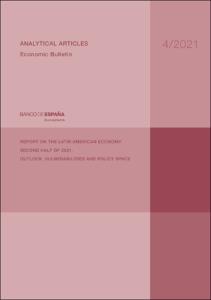Registro completo de metadatos
| Campo DC | Valor |
|---|---|
| dc.contributor.author | Banco de España. Departamento de Economía Internacional y Área del Euro |
| dc.coverage.spatial | América Latina |
| dc.date.accessioned | 2021-12-21T20:02:21Z |
| dc.date.available | 2021-12-21T20:02:21Z |
| dc.date.issued | 2021-10-27 |
| dc.identifier.uri | https://repositorio.bde.es/handle/123456789/19695 |
| dc.description | Artículo de revista |
| dc.description.abstract | The economic recovery in Latin America appears to have firmed in the second half of the year, having come to a halt in practically all the countries in Q2 owing to the unfavourable course of the pandemic. This has led in recent months to an across-the-board upward revision in growth forecasts in the region for 2021. Against this background, the region’s banking systems remain healthy, although some indicators, such as non-performing loans, are beginning to be impacted by the persistence of the crisis. There has also been a notable slowdown in lending, linked partly to the generalised withdrawal of support programmes. The path of the recovery, which is uneven from country to country, will be determined by the pandemic being overcome. It is expected that the recovery will continue to be underpinned by the strength of external demand and commodities prices, by the widespread support of economic policies (albeit gradually with less intensity) and by the favourable financing conditions in the region which, though they have recently tightened, remain accommodative in historical terms. One key conditioning factor will be inflation, which has risen notably across the region as a whole, and, specifically, how transitory this development proves. Given the high uncertainty surrounding the economic outlook, the Report presents alternative scenarios referring to a series of epidemiological, economic and financial variables. The indicators of macro-financial vulnerability in the region remain contained in the external and banking sectors but high in respect of public finances, against a backdrop of notable uncertainty over the future course of economic policies. |
| dc.format.extent | 56 p. |
| dc.language.iso | en |
| dc.publisher | Banco de España |
| dc.relation.ispartof | Economic Bulletin / Banco de España, 4/2021 |
| dc.relation.hasversion | Versión en español 123456789/19142 |
| dc.rights | Reconocimiento-NoComercial-CompartirIgual 4.0 Internacional (CC BY-NC-SA 4.0) |
| dc.rights | In Copyright - Non Commercial Use Permitted |
| dc.rights.uri | https://creativecommons.org/licenses/by-nc-sa/4.0/deed.es_ES |
| dc.rights.uri | http://rightsstatements.org/vocab/InC-NC/1.0/ |
| dc.subject | Latin America |
| dc.subject | Latin American economy |
| dc.subject | Economic outlook |
| dc.subject | Health crisis |
| dc.subject | Mobility |
| dc.subject | Commodities |
| dc.subject | Inflation |
| dc.subject | Financing conditions |
| dc.subject | Capital flows |
| dc.subject | Household savings |
| dc.subject | Political and social unrest |
| dc.subject | Monetary policy |
| dc.subject | Public debt sustainability |
| dc.subject | IMF Special Drawing Rights |
| dc.subject | International economy |
| dc.title | Report on the Latin American Economy: second half of 2021: outlook, vulnerabilities and policy space |
| dc.type | Artículo |
| dc.identifier.bdebib | 000472276 |
| dc.identifier.bdepub | ECBU-2021-4B-art38 |
| dc.subject.bde | Fluctuaciones y ciclos económicos |
| dc.subject.bde | Evolución y desarrollo económicos |
| dc.subject.bde | Economía internacional |
| dc.publisher.bde | Madrid : Banco de España, 2021 |
| dc.subject.jel | C11 |
| dc.subject.jel | E31 |
| dc.subject.jel | E52 |
| dc.subject.jel | E58 |
| dc.subject.jel | E62 |
| dc.subject.jel | F01 |
| dc.subject.jel | F30 |
| dc.subject.jel | F47 |












